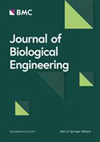
Journal of Biological Engineering
J BIOL ENG
期刊介绍
Biological engineering is an emerging discipline that encompasses engineering theory and practice connected to and derived from the science of biology, just as mechanical engineering and electrical engineering are rooted in physics and chemical engineering in chemistry. Topical areas include, but are not limited to:Synthetic biology and cellular designBiomolecular, cellular and tissue engineering Bioproduction and metabolic engineeringBiosensorsEcological and environmental engineeringBiological engineering education and the biodesign processAs the official journal of the Institute of Biological Engineering, Journal of Biological Engineering provides a home for the continuum from biological information science, molecules and cells, product formation, wastes and remediation, and educational advances in curriculum content and pedagogy at the undergraduate and graduate-levels.Manuscripts should explore commonalities with other fields of application by providing some discussion of the broader context of the work and how it connects to other areas within the field.
生物工程是一门新兴学科,它包含与生物科学相关的工程理论和实践,就像机械工程和电气工程植根于物理学,化学工程植根于化学。主题领域包括,但不限于:合成生物学和细胞设计生物分子、细胞和组织工程生物生产和代谢工程生物传感器生态和环境工程生物工程教育和生物设计过程作为生物工程研究所的官方期刊,《生物工程杂志》提供了一个从生物信息科学、分子和细胞、产品形成、废物和修复,以及本科和研究生课程内容和教学法的教育进展的连续体的家园。稿件应通过提供一些工作的更广泛背景的讨论以及如何与该领域内的其他领域联系来探索与其他应用领域的共性。
| 年发文量 | 70 |
| 国人发稿量 | 14 |
| 国人发文占比 | 20.51% |
| 自引率 | 0.0% |
| 平均录取率 | - |
| 平均审稿周期 | 17 Weeks |
| 版面费 | 1,430 GBP |
| 偏重研究方向 | BIOCHEMICAL RESEARCH METHODS-BIOTECHNOLOGY & APPLIED MICROBIOLOGY |
| 期刊官网 | https://www.springer.com/journal/13036 |
| 投稿链接 | https://www.editorialmanager.com/JBIE |
质量指标占比
| 研究类文章占比 | OA被引用占比 | 撤稿占比 | 出版后修正文章占比 |
|---|---|---|---|
| 84.29% | 99.45% | - | - |
相关指数
期刊预警不是论文评价,更不是否定预警期刊发表的每项成果。《国际期刊预警名单(试行)》旨在提醒科研人员审慎选择成果发表平台、提示出版机构强化期刊质量管理。
预警期刊的识别采用定性与定量相结合的方法。通过专家咨询确立分析维度及评价指标,而后基于指标客观数据产生具体名单。
具体而言,就是通过综合评判期刊载文量、作者国际化程度、拒稿率、论文处理费(APC)、期刊超越指数、自引率、撤稿信息等,找出那些具备风险特征、具有潜在质量问题的学术期刊。最后,依据各刊数据差异,将预警级别分为高、中、低三档,风险指数依次减弱。
《国际期刊预警名单(试行)》确定原则是客观、审慎、开放。期刊分区表团队期待与科研界、学术出版机构一起,夯实科学精神,打造气正风清的学术诚信环境!真诚欢迎各界就预警名单的分析维度、使用方案、值得关切的期刊等提出建议!
预警情况
查看说明
| 时间 | 预警情况 |
|---|---|
| 2025年03月发布的2025版 | 不在预警名单中 |
| 2024年02月发布的2024版 | 不在预警名单中 |
| 2023年01月发布的2023版 | 不在预警名单中 |
| 2021年12月发布的2021版 | 不在预警名单中 |
| 2020年12月发布的2020版 | 不在预警名单中 |
JCR分区 WOS分区等级:Q1区
| 版本 | 按学科 | 分区 |
|---|---|---|
|
WOS期刊SCI分区
WOS期刊SCI分区是指SCI官方(Web of Science)为每个学科内的期刊按照IF数值排
序,将期刊按照四等分的方法划分的Q1-Q4等级,Q1代表质量最高,即常说的1区期刊。
(2021-2022年最新版)
|
||
| BIOCHEMICAL RESEARCH METHODS | Q1 | |
| BIOTECHNOLOGY & APPLIED MICROBIOLOGY | Q1 |
关于2019年中科院分区升级版(试行)
分区表升级版(试行)旨在解决期刊学科体系划分与学科发展以及融合趋势的不相容问题。由于学科交叉在当代科研活动的趋势愈发显著,学科体系构建容易引发争议。为了打破学科体系给期刊评价带来的桎梏,“升级版方案”首先构建了论文层级的主题体系,然后分别计算每篇论文在所属主题的影响力,最后汇总各期刊每篇论文分值,得到“期刊超越指数”,作为分区依据。
分区表升级版(试行)的优势:一是论文层级的主题体系既能体现学科交叉特点,又可以精准揭示期刊载文的多学科性;二是采用“期刊超越指数”替代影响因子指标,解决了影响因子数学性质缺陷对评价结果的干扰。整体而言,分区表升级版(试行)突破了期刊评价中学科体系构建、评价指标选择等瓶颈问题,能够更为全面地揭示学术期刊的影响力,为科研评价“去四唯”提供解决思路。相关研究成果经过国际同行的认可,已经发表在科学计量学领域国际重要期刊。
《2019年中国科学院文献情报中心期刊分区表升级版(试行)》首次将社会科学引文数据库(SSCI)期刊纳入到分区评估中。升级版分区表(试行)设置了包括自然科学和社会科学在内的18个大类学科。基础版和升级版(试行)将过渡共存三年时间,推测在此期间各大高校和科研院所仍可能会以基础版为考核参考标准。 提示:中科院分区官方微信公众号“fenqubiao”仅提供基础版数据查询,暂无升级版数据,请注意区分。
中科院分区
查看说明
| 版本 | 大类学科 | 小类学科 | Top期刊 | 综述期刊 |
|---|---|---|---|---|
|
生物学
2区
|
BIOCHEMICAL RESEARCH METHODS
生化研究方法
2区
BIOTECHNOLOGY & APPLIED MICROBIOLOGY
生物工程与应用微生物
2区
|
未知 | 未知 | |
|
2021年12月
基础版
|
生物
3区
|
BIOCHEMICAL RESEARCH METHODS
生化研究方法
3区
BIOTECHNOLOGY & APPLIED MICROBIOLOGY
生物工程与应用微生物
3区
|
未知 | 未知 |
|
2021年12月
升级版
|
生物学
3区
|
BIOCHEMICAL RESEARCH METHODS
生化研究方法
3区
BIOTECHNOLOGY & APPLIED MICROBIOLOGY
生物工程与应用微生物
3区
|
未知 | 未知 |
|
2020年12月
旧的升级版
|
生物学
3区
|
BIOCHEMICAL RESEARCH METHODS
生化研究方法
3区
BIOTECHNOLOGY & APPLIED MICROBIOLOGY
生物工程与应用微生物
3区
|
未知 | 未知 |
|
2022年12月
最新升级版
|
生物学
3区
|
BIOCHEMICAL RESEARCH METHODS
生化研究方法
3区
BIOTECHNOLOGY & APPLIED MICROBIOLOGY
生物工程与应用微生物
3区
|
未知 | 未知 |














